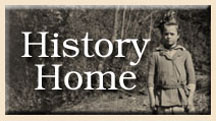

Pi Beta Phi Health Care Program
From the moment Pi Beta Phi established its settlement school on the banks
of the Little Pigeon River, the Fraternity sought to improve health care standards
in Gatlinburg and its smaller satellite communities. As early as 1914, in
fact, three of Pi Beta Phi’s twelve founders donated the rather substantial
sum of $150 apiece to be used in the construction of a small clinic on the
settlement school grounds. It would, sadly, take six more years for their
dream to be realized, for economic difficulties arising from American involvement
in the First World War prevented the fraternity from purchasing lumber and
other supplies. And so, the settlement school staff did what it could during
the intervening years to influence health and hygiene in Gatlinburg, until
such time as the clinic could be built and a professional nurse hired to oversee
its operation.
The first recorded instance of the settlement school staff taking direct action
to improve health and hygiene standards in Gatlinburg occurred during the
tenure of teacher Mary O. Pollard (1913-1916). During her three years at the
settlement school, Pollard worked tirelessly to eradicate hookworm from the
communities within her reach, both by assisting with State Hookworm Clinics
held on the settlement school campus, and by spending her summers “walking
miles and miles to tell people of the danger of hookworm and urging them to
come in to receive . . . treatment at the Pi Phi School.” A second staff
member who distinguished herself in the field of health reform despite lacking
formal medical training was Evelyn Bishop, who served the Settlement School
as Head Resident from 1918-1933. During the 1917-1918 Spanish Influenza pandemic,
which claimed the lives of approximately 675,000 Americans (and as many as
40 million worldwide), Gatlinburg residents looked to the Settlement School,
and Bishop in particular, for help. Although there was little that she could
do as a layperson, other than assist local doctors in caring for the sick,
her steady presence paid dividends for the settlement school project. “Since
that great scourge,” wrote a Sevierville doctor, “the sentiment
is entirely changed toward the school. . . . The people now seem to be working
together for the advancement of the school and community.”
Interestingly enough, the pandemic served a second, greater purpose as well;
for although Bishop performed admirably during the crisis, it was evident
to everyone involved with the Settlement School project that Gatlinburg needed
the services of a professional nurse. Without wasting any time, the Settlement
School Committee convinced one of the Fraternity’s own, Alberta, Canada
native Phyllis Higinbotham, to travel to Gatlinburg and take charge of the
community’s health care needs. Following brief stints at New York’s
Henry Street Settlement House, where she received her introduction to settlement
work, and the Hindman Settlement School in Hindman, Kentucky, during which
time she gained valuable insight into the cultural standards of mountain families,
she made her way to Gatlinburg in the fall of 1920.
Higinbotham’s job was, by any standard, Herculean; there were “about
two hundred families in this [school] district,” most of whom needed
some sort of treatment (poor eyesight and tonsillitis were very common among
the mountaineers) and most of whom lived at the end of very poor roads. And
yet, undaunted, she took to her task with gusto. During her first two years
at the Settlement School, Higinbotham made close to 2,000 trips into the mountainous
backcountry surrounding Gatlinburg, giving first aid to the injured, examining
newborn babies, and administering inoculations to children and adults alike.
More often than not, she traveled without the benefit of a map, and so was
dependent on the goodwill of the local people to help her find her way. For
the most part, Nurse Higinbotham’s only companions on these long and
tiresome journeys were her horse, “Lady,” and a collie named “Rex”
which belonged to Settlement School agricultural teacher Otto J. Mattil.
| <<< Back |
 |
|